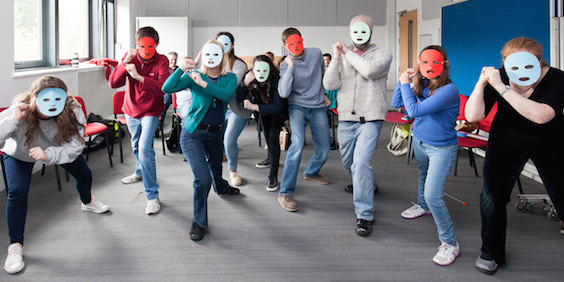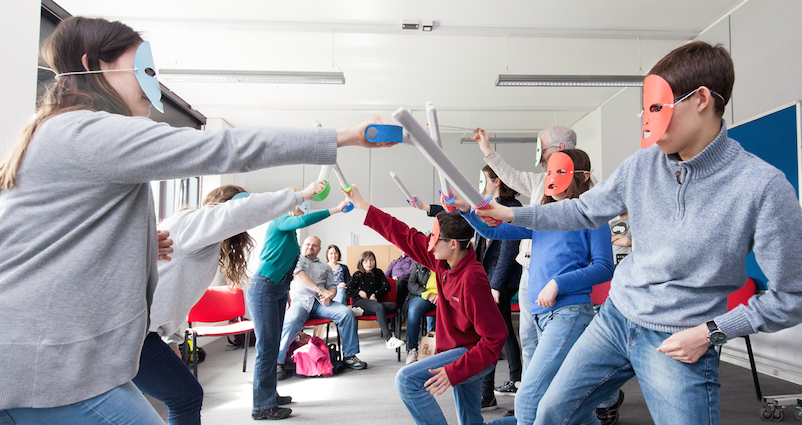
May 22, 2015, by Oliver Thomas
May Fest 2015
Undergraduates Karina Field and Juliet O’Brien describe their experiences helping out at May Fest, the University’s annual community open day.
Karina:
To prepare for our ‘Roman-style hairdressing service’, we learned several hairstyles from Janet Stephens’ YouTube tutorials. We then recreated parts of them for the children (and parents) that were willing. We offered two styles: two plaits into a low bun; and hair wrapped round a ribbon to look like a crown.
 The stall was popular with long-haired mothers and daughters alike (no long-haired boys joined in). I really enjoyed helping out, particularly as some of the children were so enthusiastic to tell us about what they knew about the Romans from school. Once they had had their hair done, they could pop into the Digital Humanities Centre and have their face put on a Roman coin. The DHC also had costumes for the photoshoot, including laurel wreaths or helmets for the boys. The outcomes looked great!
The stall was popular with long-haired mothers and daughters alike (no long-haired boys joined in). I really enjoyed helping out, particularly as some of the children were so enthusiastic to tell us about what they knew about the Romans from school. Once they had had their hair done, they could pop into the Digital Humanities Centre and have their face put on a Roman coin. The DHC also had costumes for the photoshoot, including laurel wreaths or helmets for the boys. The outcomes looked great!
While the hairdressing was going on, Jack Lennon was fortune-telling: people could ask about slaves who had been kidnapped by pirates, or learn from an animal liver what they should do to please the gods. I hadn’t realised that such prophecies could have been bought on the street, almost as if from a vending machine. Everyone seemed to really enjoy the fortune-telling: magic/superstition is always a winner with children!
Juliet:
“I sing of arms and of the man…”, Virgil began his Aeneid. If he had been describing the May Fest performances of Book 2 he would have sung of cardboard masks and child actors but, dare I say, with just as much enthusiasm.
 We chose the story of the Trojan Horse not just because it might be familiar to some of the children, but also because it is so inspiring a tale. Who can fail to pity the poor Trojans, cruelly deceived by the wooden horse into thinking the terrible war is over? Or to sympathise with Aeneas’ noble determination to carry his father from the destruction of the city?
We chose the story of the Trojan Horse not just because it might be familiar to some of the children, but also because it is so inspiring a tale. Who can fail to pity the poor Trojans, cruelly deceived by the wooden horse into thinking the terrible war is over? Or to sympathise with Aeneas’ noble determination to carry his father from the destruction of the city?
My job was to narrate the story at the first session. I was nervous that children would struggle to relate to a story written thousands of years ago, and to act it out without making sounds, conveying emotion instead mainly with their limbs. But it was a lovely surprise to see how little encouragement they needed to try the warm-up exercises, such as miming the opening of the city gates. They were even more eager to do sword-fights, which we did in slow motion, as if in a vast ancient theatre where the audience at the back still had to be able to make it out.
There were some Oscar-worthy performances: mothers showed surprising sword skills, small girls gave realistic portrayals of Aeneas’ heartbreak as his city burned, and many moving deaths were depicted. Those too shy to participate followed the action closely, knowing that actors feed off a good audience.
The response to our story-telling event showed that Classics offers a wealth of fascinating stories that cannot fail to engage people’s imaginations, even when met for the first time. Learning about the Ancient World and being able to pass on that knowledge is a great privilege, but also lots of fun!
Image credits: top and bottom, (c) University of Nottingham; middle right, (c) Digital Humanities Centre.
No comments yet, fill out a comment to be the first

Leave a Reply